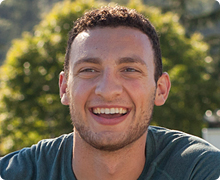Better Concussion Care
A strategic gift brings together the expertise needed to better understand, prevent and treat concussions in kids and teens.
Published in Connection magazine, Fall 2017
 Amit Perlin is now a junior in college, and his interest in medicine was spurred, in part, by his experience with persistent concussion symptoms. Dealing with ongoing symptoms was really tough, recalls Perlin. “There’s no cast or physical scar that shows you’ve been injured, so people can’t always understand that you’re hurting. But you use your brain for everything and the symptoms can limit your life in almost every way.”
Amit Perlin is now a junior in college, and his interest in medicine was spurred, in part, by his experience with persistent concussion symptoms. Dealing with ongoing symptoms was really tough, recalls Perlin. “There’s no cast or physical scar that shows you’ve been injured, so people can’t always understand that you’re hurting. But you use your brain for everything and the symptoms can limit your life in almost every way.”
Each year, somewhere between 1.1 million and 1.7 million kids sustain a sports- or recreation-related concussion.
The good news is that most feel better within 10 to 14 days. But some – between 10% and 20% – remain symptomatic for weeks or months afterward.
Amit Perlin was one of those kids. His first concussion resolved within a couple of weeks, as expected. But the second one, sustained during his junior year in high school, resulted in severe headaches, fatigue and nausea that lasted for nearly a year. The standout basketball player at Seattle Academy of Arts and Sciences suddenly couldn’t tolerate noise or light, and his limited ability to concentrate or work at a computer took a toll on his school work. Over time, the usually outgoing teen found himself retreating from friends and social situations.
“It was like my life was taken away from me. I couldn’t do things I was used to doing, and I became solitary and sad,” recalls Perlin, who recently started his junior year at Tulane University in New Orleans.
What made it worse was that no one could tell his family what to expect, how long the symptoms would continue, or what would help.
“It was shocking how little concrete information there was for such a common injury.”
“We know medicine isn’t an exact science, but it was shocking how little concrete information there was for such a common injury,” says his mom, Sharon Perlin. “It’s hard to see your kid in a dark space and not know how to help.”
Filling in the gaps
A $5 million gift from the Satterberg Foundation in 2014 established the Seattle Pediatric Concussion Research Collaborative, propelling efforts to fill in these knowledge gaps by investigating the mechanisms of concussion, how the injury impacts functioning, and how it can be treated more effectively.
The group brings together experts from the wide range of specialties involved in the treatment and study of youth concussion (including pediatrics, rehabilitation medicine, sports medicine, neurosurgery, psychology and radiology) to generate creative ways to address the issue. It also funds pilot studies to test out these new ideas. The goal is to produce results that are compelling enough to attract support needed from external funders like the National Institutes of Health (NIH) to test these on a larger scale – an essential step to establishing better care for kids.
Caring for mind and body
One of the first studies tested a new model of care for adolescents, like Perlin, whose symptoms continue beyond the norm.
“Persistent symptoms are important because kids can be quite incapacitated and we don’t yet have good, evidencedbased treatments,” says Dr. Fred Rivara, Seattle Children’s Guild Endowed Chair in Pediatrics, who spearheads the collaborative. “We want to find ways to get them back to full functioning as quickly as possible.”
Dr. Cari McCarty, a psychologist and researcher at Seattle Children’s, and University of Washington psychiatrist Dr. Doug Zatzick designed a care model that features a care manager to coordinate between the family, the specialists, the primary care doctor and (if necessary) the school. It also includes cognitive behavioral therapy (CBT) to help kids cope with what they are going through.
“CBT involves changing behaviors and thinking patterns. Our study included teaching relaxation techniques and coping skills, and offering pain management,” says McCarty.
The small pilot study found that those who received collaborative care got better more quickly than those who received the usual care. Thanks to these results, Rivara, McCarty and Zatzick secured a $2.5 million grant from the NIH to lead a four-year study of the collaborative care model with a larger group of patients.
Freedom to try
“The Satterberg Foundation gave us the freedom to pursue the areas of greatest need within the broader theme of concussion. It allows us to create a mini-model of something new and test these ideas and concepts on a small scale before taking them to a larger setting,” says McCarty. “It’s like that first stage of building a snowman where you create the base. From there you can build something wonderful and new. That’s been the real gift to us.”